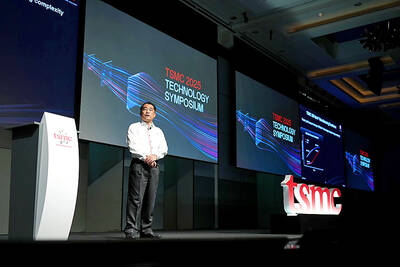Sumitomo Life Insurance Co, Japan’s fourth-largest life insurer, plans to try to raise about ¥100 billion (US$1.1 billion) in capital as early as next month to strengthen its financial base, a spokesman said.
The Osaka-based life insurer is considering borrowing perpetual subordinated loans from domestic banks, including Sumitomo Mitsui Financial Group Inc, Sumitomo Life spokesman Yoshiki Miyazaki said by telephone yesterday.
Japanese life insurers are bolstering their balance sheets as the worst financial crisis since the Great Depression erodes the value of their investments and earnings. Insurers are taking action because the government may move to tighten capital rules.
‘IMPROVING CAPITAL’
“Choosing perpetual subordinated loans to raise funds is aimed at improving capital quality in advance as we anticipate that capital requirements may become stricter,” Miyazaki said.
Mitsui Life Insurance Co said this month it will raise ¥60 billion to boost capital, while Asahi Mutual Life Insurance Co last month said it aims to raise about 35 billion yen by year’s end.
“There’s a possibility that life insurers’ assets have deteriorated considerably amid the financial crisis,” said Susumu Kato, chief economist at Calyon Securities in Tokyo. Japanese life insurers, of which many are mutual corporations, “have little choice but to boost capital in order to pay policyholders in a stable manner.”
FALLING PROFITS
Unrealized profits on the securities Sumitomo Life holds fell to ¥120 billion at the end of September from ¥711 billion a year earlier, according to the company’s statement.
“There’s no problem in the company’s financial health” because Sumitomo Life’s solvency margin stood at 996 percent at the end of September, Miyazaki said.
Solvency margin ratio is a gauge of life insurers’ ability to pay policyholders. Sumitomo Life’s ratio was the fifth highest among Japan’s nine biggest insurers at the end of September. The industry requires the ratio to be more than 200 percent, the threshold for a healthy life insurer.
The Nikkei newspaper reported earlier yesterday Sumitomo Life may boost capital in January. The paper said the insurer may buy preferred securities issued by Sumitomo Mitsui Financial.
FORECAST CUT
T&D Holdings Inc, Japan’s biggest publicly traded life insurer, cut its full-year net income forecast by 95 percent last month to ¥2 billion, citing losses on stock investments.
Asahi Life posted 112 billion yen of unrealized losses at the end of September, the company’s earnings statement showed.

DEMOGRAPHICS: Robotics is the most promising answer to looming labor woes, the long-term care system and national contingency response, an official said Taiwan is to launch a five-year plan to boost the robotics industry in a bid to address labor shortages stemming from a declining and aging population, the Executive Yuan said yesterday. The government approved the initiative, dubbed the Smart Robotics Industry Promotion Plan, via executive order, senior officials told a post-Cabinet meeting news conference in Taipei. Taiwan’s population decline would strain the economy and the nation’s ability to care for vulnerable and elderly people, said Peter Hong (洪樂文), who heads the National Science and Technology Council’s (NSTC) Department of Engineering and Technologies. Projections show that the proportion of Taiwanese 65 or older would

Nvidia Corp yesterday unveiled its new high-speed interconnect technology, NVLink Fusion, with Taiwanese application-specific IC (ASIC) designers Alchip Technologies Ltd (世芯) and MediaTek Inc (聯發科) among the first to adopt the technology to help build semi-custom artificial intelligence (AI) infrastructure for hyperscalers. Nvidia has opened its technology to outside users, as hyperscalers and cloud service providers are building their own cost-effective AI chips, or accelerators, used in AI servers by leveraging ASIC firms’ designing capabilities to reduce their dependence on Nvidia. Previously, NVLink technology was only available for Nvidia’s own AI platform. “NVLink Fusion opens Nvidia’s AI platform and rich ecosystem for

Taiwan Semiconductor Manufacturing Co (TSMC, 台積電) yesterday said it is building nine new advanced wafer manufacturing and packaging factories this year, accelerating its expansion amid strong demand for high-performance computing (HPC) and artificial intelligence (AI) applications. The chipmaker built on average five factories per year from 2021 to last year and three from 2017 to 2020, TSMC vice president of advanced technology and mask engineering T.S. Chang (張宗生) said at the company’s annual technology symposium in Hsinchu City. “We are quickening our pace even faster in 2025. We plan to build nine new factories, including eight wafer fabrication plants and one advanced

‘WORLD’S LOSS’: Taiwan’s exclusion robs the world of the benefits it could get from one of the foremost practitioners of disease prevention and public health, Minister Chiu said Taiwan should be allowed to join the World Health Assembly (WHA) as an irreplaceable contributor to global health and disease prevention efforts, Minister of Foreign Affairs Lin Chia-lung (林佳龍) said yesterday. He made the comment at a news conference in Taipei, hours before a Taiwanese delegation was to depart for Geneva, Switzerland, seeking to meet with foreign representatives for a bilateral meeting on the sidelines of the WHA, the WHO’s annual decisionmaking meeting, which would be held from Monday next week to May 27. As of yesterday, Taiwan had yet to receive an invitation. Taiwan has much to offer to the international community’s